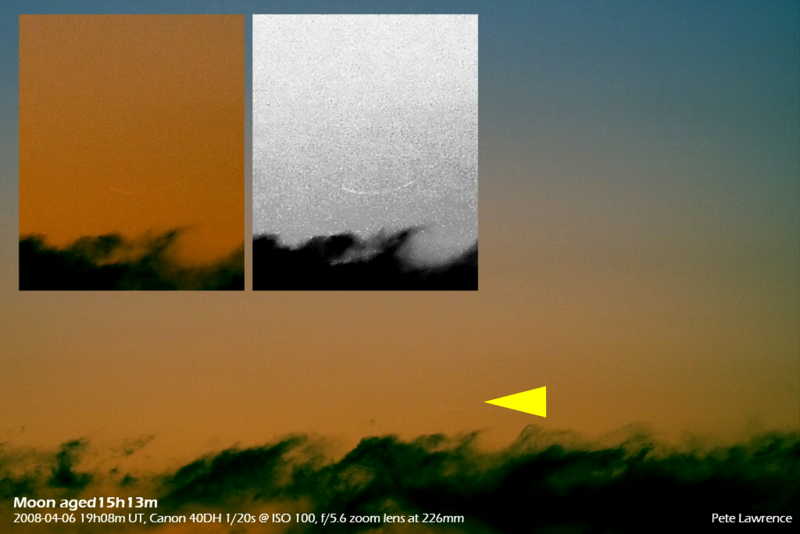2021 September 4
Observer’s Challenge – September’s Thin Moon

As astronomical targets go, it has to be said that the Moon is one of the easiest. Big and bright, it’s hardly a challenge to find, except for the 72-hour window centred on new Moon. This is the phase when the Moon lines up with the Sun in the sky, typically appearing north or south of the Sun’s disc. When the alignment is a little more precise, the Moon can appear to pass in front of the Sun and we get a solar eclipse.
Immediately before the new phase, the Moon appears as a slender waning crescent in the morning sky. Immediately after new Moon, it appears as a waxing crescent in the evening twilight. A theoretical limit is set in respect to how far the Moon has to be from the Sun in order to see it. The so-called Danjon limit, suggests that the crescent Moon can’t be seen unless the apparent separation between the Sun and Moon is in excess of 7 degrees.
Unlike the ‘regular’ phases of the Moon, when it appears against a dark sky, the thin crescent phases can be pretty challenging. The closer the Moon is to the Danjon limit, the tougher it is to see. Different times of year are better than others. The evening waxing crescent Moon is optimally presented in the spring months when the ecliptic has a steep angle to the western horizon after sunset. Waning crescents are poorly positioned in the spring due to a shallow ecliptic angle towards the east before sunrise. The situation is reversed in the autumn with the morning crescents being well presented, the evening ones less so.

The Moon reaches its new phase at 01:51 BST (00:51 UT) on 7 September. On the morning of 6 September there’s an opportunity to spot a 0.9%-lit waning crescent Moon, low above the east-northeast horizon. Rising 75 minutes before the Sun, this particular crescent is optimally located, rising vertically above the Sun’s position. As ever, if you’re looking for it, stop just before the Sun rises for safety. If you do manage to see it, congratulations as you’ve just seen a Moon which is less than 20 hours from new.
On the evening of 7 September, there’s an opportunity to catch a 0.6%-lit waxing crescent, potentially visible 20 minutes after sunset, low above the western horizon. This one will be extremely tricky, setting just 40 minutes after the Sun. If you catch it, this will be less than 18 hours from new.
The waning crescent Moon on 6 September presents a great opportunity to hone your observing skills and to catch an incredibly well-placed, less than 1%-lit lunar crescent. The waxing crescent on the evening of the 7th is a real challenge which will test your observing skills to the limit.
If you manage to catch the thinnest Moon, please share in your Members’ Album.

https://britastro.org/wp-content/uploads/2022/02/BAA_2021-09_CHA-teaser.png
https://britastro.org/wp-content/uploads/2022/02/BAA_2021-09_CHA-teaser.png
https://britastro.org/wp-content/uploads/2022/02/BAA_2021-09_CHA-teaser.png
https://britastro.org/wp-content/uploads/2022/02/BAA_2021-09_CHA-teaser.png
https://britastro.org/wp-content/uploads/2022/02/BAA_2021-09_CHA-teaser.png
https://britastro.org/wp-content/uploads/2022/02/BAA_2021-09_CHA-teaser.png
https://britastro.org/wp-content/uploads/2022/02/BAA_2021-09_CHA-teaser.png
https://britastro.org/wp-content/uploads/2022/02/BAA_2021-09_CHA-teaser.png
https://britastro.org/wp-content/uploads/2022/02/BAA_2021-09_CHA-teaser.png
https://britastro.org/wp-content/uploads/2022/02/BAA_2021-09_CHA-teaser.png
https://britastro.org/wp-content/uploads/2022/02/BAA_2021-09_CHA-teaser.png
https://britastro.org/wp-content/uploads/2022/02/BAA_2021-09_CHA-teaser.png
https://britastro.org/wp-content/uploads/2022/02/BAA_2021-09_CHA-teaser.png
https://britastro.org/wp-content/uploads/2022/02/BAA_2021-09_CHA-teaser.png
https://britastro.org/wp-content/uploads/2022/02/BAA_2021-09_CHA-teaser.png
https://britastro.org/wp-content/uploads/2022/02/BAA_2021-09_CHA-teaser.png
https://britastro.org/wp-content/uploads/2022/02/BAA_2021-09_CHA-teaser.png
https://britastro.org/wp-content/uploads/2022/02/BAA_2021-09_CHA-teaser.png
https://britastro.org/wp-content/uploads/2022/03/BAA_2021-09_CHA-teaser.png
https://britastro.org/wp-content/uploads/2022/03/BAA_2021-09_CHA-teaser.png
https://britastro.org/wp-content/uploads/2022/02/BAA_2021-09_CHA-teaser.png
https://britastro.org/wp-content/uploads/2021/09/BAA_2021-09_CHA_15h13m_crescent_IMG_1299_1024.png
https://britastro.org/wp-content/uploads/2021/09/BAA_2021-09_CHA-teaser.png
https://britastro.org/wp-content/uploads/2022/02/BAA_2021-09_CHA-teaser.png
https://britastro.org/wp-content/uploads/2022/02/BAA_2021-09_CHA-teaser.png
https://britastro.org/wp-content/uploads/2022/02/BAA_2021-09_CHA-teaser.png
https://britastro.org/wp-content/uploads/2022/02/BAA_2021-09_CHA-teaser.png
https://britastro.org/wp-content/uploads/2022/02/BAA_2021-09_CHA-teaser.png
https://britastro.org/wp-content/uploads/2022/02/BAA_2021-09_CHA-teaser.png
https://britastro.org/wp-content/uploads/2022/02/BAA_2021-09_CHA-teaser.png
https://britastro.org/wp-content/uploads/2021/09/BAA_2021-09_CHA.png
https://britastro.org/wp-content/uploads/2022/02/BAA_2021-09_CHA-teaser.png
https://britastro.org/wp-content/uploads/2022/02/BAA_2021-09_CHA-teaser.png
https://britastro.org/wp-content/uploads/2022/02/BAA_2021-09_CHA-teaser.png
https://britastro.org/wp-content/uploads/2022/02/BAA_2021-09_CHA-teaser.png
https://britastro.org/wp-content/uploads/2022/02/BAA_2021-09_CHA-teaser.png
https://britastro.org/wp-content/uploads/2022/02/BAA_2021-09_CHA-teaser.png
https://britastro.org/wp-content/uploads/2022/02/BAA_2021-09_CHA-teaser.png
https://britastro.org/wp-content/uploads/2022/02/BAA_2021-09_CHA-teaser.png
| The British Astronomical Association supports amateur astronomers around the UK and the rest of the world. Find out more about the BAA or join us. |
